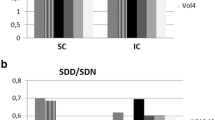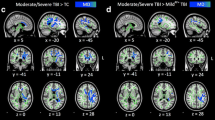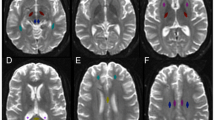Abstract
The temporal stem (TS) of the temporal lobe is a major white matter (WM) region containing several major pathways that connect the temporal lobe with the rest of the brain. Because of its location, it may be particularly vulnerable to shear-strain effects resulting from traumatic brain injury (TBI). A case vignette is presented in a patient with severe brain injury and focal TS pathology. Also, 12 severe TBI subjects unselected for TS pathology were compared to demographically matched, neurologically-intact controls using diffusion tensor imaging (DTI) to examine white matter tracts associated with the TS, including the inferior fronto-occipital fasciculus (IFOF), inferior longitudinal fasciculus (ILF), arcuate fasciculus (AF), cingulum bundle (CB) and the uncinate fasciculus (UF). For each tract, fractional anisotropy (FA) and apparent diffusion coefficient (ADC) were computed and compared between the two groups and also examined in relationship to memory performance in the TBI subjects. Significant FA and ADC differences were observed in all tracts in the TBI patients compared to controls, with several relationships with memory outcome noted in the IFOF, ILF and AF. Based on these preliminary findings, the potential role of TBI-induced WM disconnection involving the TS is discussed as well as the relationship of TS damage to neurobehavioral outcome. The need for future studies specifically examining the role of TS injury in TBI is emphasized.





Similar content being viewed by others
References
Adolphs, R. (2003). Cognitive neuroscience of human social behaviour. Nature Reviews. Neuroscience, 4(3), 165–178.
Andersen, P., Morris, R., Amaral, D., Bliss, T., & O’Keefe, J. (2006). The hippocampus book. New York: Oxford University Press.
Ariza, M., Pueyo, R., Junque, C., Mataro, M., Poca, M. A., Mena, M. P., et al. (2006). Differences in visual vs. verbal memory impairments as a result of focal temporal lobe damage in patients with traumatic brain injury. Brain Injury, 20(10), 1053–1059.
Bayly, P. V., Cohen, T. S., Leister, E. P., Ajo, D., Leuthardt, E. C., & Genin, G. M. (2005). Deformation of the human brain induced by mild acceleration. Journal of Neurotrauma, 22(8), 845–856.
Bigler, E. D. (2007). Anterior and middle cranial fossa in traumatic brain injury (TBI): relevant neuroanatomy and neuropathology in the study of neuropsychological outcome. Neuropsychology, 2007(21), 515–531.
Bigler, E. D., Blatter, D. D., Anderson, C. V., Johnson, S. C., Gale, S. D., Hopkins, R. O., et al. (1997). Hippocampal volume in normal aging and traumatic brain injury. AJNR. American Journal of Neuroradiology, 18(1), 11–23.
Bigler, E. D., Anderson, C. V., & Blatter, D. D. (2002). Temporal lobe morphology in normal aging and traumatic brain injury. AJNR. American Journal of Neuroradiology, 23(2), 255–266.
Bigler, E. D., Abildskov, T. J., Wilde, E. A., McCauley, S. R., Li, X., Merkley, T. L., et al. (2010). Diffuse damage in pediatric traumatic brain injury: a comparison of automated versus operator-controlled quantification methods. Neuroimage, 50(3), 1017–1026.
Bird, C. M., Shallice, T., & Cipolotti, L. (2007). Fractionation of memory in medial temporal lobe amnesia. Neuropsychologia, 45(6), 1160–1171.
Blatter, D. D., Bigler, E. D., Gale, S. D., Johnson, S. C., Anderson, C. V., Burnett, B. M., et al. (1997). MR-based brain and cerebrospinal fluid measurement after traumatic brain injury: correlation with neuropsychological outcome. AJNR. American Journal of Neuroradiology, 18(1), 1–10.
Bracht, T., Tuscher, O., Schnell, S., Kreher, B., Rusch, N., Glauche, V., et al. (2009). Extraction of prefronto-amygdalar pathways by combining probability maps. Psychiatry Research, 174(3), 217–222.
Bramlett, H. M., & Dietrich, W. D. (2002). Quantitative structural changes in white and gray matter 1 year following traumatic brain injury in rats. Acta Neuropathologica, 103(6), 607–614.
Catani, M., & Thiebaut de Schotten, M. (2008). A diffusion tensor imaging tractography atlas for virtual in vivo dissections. Cortex, 44(8), 1105–1132.
Catani, M., Howard, R. J., Pajevic, S., & Jones, D. K. (2002). Virtual in vivo interactive dissection of white matter fasciculi in the human brain. Neuroimage, 17(1), 77–94.
Choi, C. Y., Han, S. R., Yee, G. T., & Lee, C. H. (2010). A understanding of the temporal stem. Journal of the Korean Neurosurgical Society, 47(5), 365–369.
Corkin, S., Amaral, D. G., Gonzalez, R. G., Johnson, K. A., & Hyman, B. T. (1997). H. M’.s medial temporal lobe lesion: findings from magnetic resonance imaging. The Journal of Neuroscience, 17(10), 3964–3979.
Delis, D., Kramer, E., Kaplan, E., & Ober, B. (2000). California verbal learning test—2nd Ed. San Antonio: The Psychological Corporation.
Diaz-Arrastia, R., Agostini, M. A., Madden, C. J., & Van Ness, P. C. (2009). Posttraumatic epilepsy: the endophenotypes of a human model of epileptogenesis. Epilepsia, 50(Suppl 2), 14–20.
Diehl, B., Busch, R. M., Duncan, J. S., Piao, Z., Tkach, J., & Luders, H. O. (2008). Abnormalities in diffusion tensor imaging of the uncinate fasciculus relate to reduced memory in temporal lobe epilepsy. Epilepsia, 49(8), 1409–1418.
Duckworth, J. L., & Stevens, R. D. (2010). Imaging brain trauma. Current Opinion in Critical Care. 2010 February 12 [Epub ahead of print].
Eslinger, P. J., Easton, A., Grattan, L. M., & Van Hoesen, G. W. (1996). Distinctive forms of partial retrograde amnesia after asymmetric temporal lobe lesions: possible role of the occipitotemporal gyri in memory. Cerebral Cortex, 6(3), 530–539.
Fletcher, P. T., Whitaker, R. T., Tao, R., Dubray, M. B., Froehlich, A., Ravichandran, C., et al. (2010). Microstructural connectivity of the arcuate fasciculus in adolescents with high-functioning autism. Neuroimage, 51(3), 1117–25.
Fujiwara, E., Schwartz, M. L., Gao, F., Black, S. E., & Levine, B. (2008). Ventral frontal cortex functions and quantified MRI in traumatic brain injury. Neuropsychologia, 46(2), 461–474.
Gaffan, D. (2005). Neuroscience. Widespread cortical networks underlie memory and attention. Science, 309(5744), 2172–2173.
Gaffan, D., Parker, A., & Easton, A. (2001). Dense amnesia in the monkey after transection of fornix, amygdala and anterior temporal stem. Neuropsychologia, 39(1), 51–70.
Giugni, E., Sabatini, U., Hagberg, G. E., Formisano, R., & Castriota-Scanderbeg, A. (2005). Fast detection of diffuse axonal damage in severe traumatic brain injury: comparison of gradient-recalled echo and turbo proton echo-planar spectroscopic imaging MRI sequences. AJNR. American Journal of Neuroradiology, 26(5), 1140–1148.
Govindan, R. M., Makki, M. I., Sundaram, S. K., Juhasz, C., & Chugani, H. T. (2008). Diffusion tensor analysis of temporal and extra-temporal lobe tracts in temporal lobe epilepsy. Epilepsy Research, 80(1), 30–41.
Helmstaedter, C., Richter, S., Roske, S., Oltmanns, F., Schramm, J., & Lehmann, T. N. (2008). Differential effects of temporal pole resection with amygdalohippocampectomy versus selective amygdalohippocampectomy on material-specific memory in patients with mesial temporal lobe epilepsy. Epilepsia, 49(1), 88–97.
Hoogenraad, F. (2002). Multi-center evaluation of in-vivo fibertracking. Philips Medical Systems.
Horel, J. A. (1994). Some comments on the special cognitive functions claimed for the hippocampus. Cortex, 30(2), 269–280.
Jones, D. K., Horsfield, M. A., & Simmons, A. (1999). Optimal strategies for measuring diffusion in anisotropic systems by magnetic resonance imaging. Magnetic Resonance in Medicine, 42(3), 515–525.
Kelley, B. J., Farkas, O., Lifshitz, J., & Povlishock, J. T. (2006). Traumatic axonal injury in the perisomatic domain triggers ultrarapid secondary axotomy and Wallerian degeneration. Experimental Neurology, 198(2), 350–360.
Kharatishvili, I., Immonen, R., Grohn, O., & Pitkanen, A. (2007). Quantitative diffusion MRI of hippocampus as a surrogate marker for post-traumatic epileptogenesis. Brain, 130(Pt 12), 3155–3168.
Kier, E. L., Staib, L. H., Davis, L. M., & Bronen, R. A. (2004). MR imaging of the temporal stem: anatomic dissection tractography of the uncinate fasciculus, inferior occipitofrontal fasciculus, and Meyer’s loop of the optic radiation. AJNR. American Journal of Neuroradiology, 25(5), 677–691.
Larrabee, G. J., Trahan, D. E., & Levin, H. S. (2000). Normative data for a six-trial administration of the Verbal Selective Reminding Test. Clinical Neuropsychology, 14(1), 110–118.
Lavenex, P., Banta Lavenex, P., & Amaral, D. G. (2007). Postnatal development of the primate hippocampal formation. Developmental Neuroscience, 29(1–2), 179–192.
Levine, B., Black, S. E., Cabeza, R., Sinden, M., McIntosh, A. R., Toth, J. P., et al. (1998). Episodic memory and the self in a case of isolated retrograde amnesia. Brain, 121(Pt 10), 1951–1973.
Levine, B., Kovacevic, N., Nica, E. I., Cheung, G., Gao, F., Schwartz, M. L., et al. (2008). The Toronto traumatic brain injury study: injury severity and quantified MRI. Neurology, 70(10), 771–778.
Lezak, M. D., Howieson, D. B., & Loring, D. W. (2004). Neuropsychological assessment. New York: Oxford University Press.
MacDonald, C. L., Schwarze, N., Vaishnavi, S. N., Epstein, A. A., Snyder, A. Z., Raichle, M. E., et al. (2008). Verbal memory deficit following traumatic brain injury: assessment using advanced MRI methods. Neurology, 71(15), 1199–1201.
Mori, S., Crain, B. J., Chacko, V. P., & van Zijl, P. C. (1999). Three-dimensional tracking of axonal projections in the brain by magnetic resonance imaging. Annals of Neurology, 45(2), 265–269.
Neil, J. J. (2008). Diffusion imaging concepts for clinicians. Journal of Magnetic Resonance Imaging, 27(1), 1–7.
Netsch, T. (2001). Towards real-time multi-modality 3-D medical image registration. Paper presented at the International Conference on Computer Vision.
Neves, G., Cooke, S. F., & Bliss, T. V. (2008). Synaptic plasticity, memory and the hippocampus: a neural network approach to causality. Nature Reviews. Neuroscience, 9(1), 65–75.
Ng, K., Mikulis, D. J., Glazer, J., Kabani, N., Till, C., Greenberg, G., et al. (2008). Magnetic resonance imaging evidence of progression of subacute brain atrophy in moderate to severe traumatic brain injury. Archives of Physical Medicine and Rehabilitation, 89(12 Suppl), S35–44.
Peltier, J., Verclytte, S., Delmaire, C., Pruvo, J. P., Godefroy, O., & Le Gars, D. (2009). Microsurgical anatomy of the temporal stem: clinical relevance and correlations with diffusion tensor imaging fiber tracking. Journal of Neurosurgery, 112(5), 1033–8.
Petrides, M., & Pandya, D. N. (2007). Efferent association pathways from the rostral prefrontal cortex in the macaque monkey. The Journal of Neuroscience, 27(43), 11573–11586.
Pugliese, L., Catani, M., Ameis, S., Dell’Acqua, F., Thiebaut de Schotten, M., Murphy, C., et al. (2009). The anatomy of extended limbic pathways in Asperger syndrome: a preliminary diffusion tensor imaging tractography study. Neuroimage, 47(2), 427–434.
Rempel-Clower, N. L. (2007). Role of orbitofrontal cortex connections in emotion. Annals of the New York Academy of Sciences, 1121, 72–86.
Rey, A. (1941). Psychological examination of traumatic encephalopathy. Archives de Psychologie, 28, 286–340.
Scheid, R., Ott, D. V., Roth, H., Schroeter, M. L., & von Cramon, D. Y. (2007). Comparative magnetic resonance imaging at 1.5 and 3 Tesla for the evaluation of traumatic microbleeds. Journal of Neurotrauma, 24(12), 1811–1816.
Schoene-Bake, J. C., Faber, J., Trautner, P., Kaaden, S., Tittgemeyer, M., Elger, C. E., et al. (2009). Widespread affections of large fiber tracts in postoperative temporal lobe epilepsy. Neuroimage, 46(3), 569–576.
Sepulcre, J., Masdeu, J. C., Sastre-Garriga, J., Goni, J., Velez-de-Mendizabal, N., Duque, B., et al. (2008). Mapping the brain pathways of declarative verbal memory: evidence from white matter lesions in the living human brain. Neuroimage, 42(3), 1237–1243.
Shamy, J. L., Carpenter, D. M., Fong, S. G., Murray, E. A., Tang, C. Y., Hof, P. R., et al. (2010). Alterations of white matter tracts following neurotoxic hippocampal lesions in macaque monkeys: a diffusion tensor imaging study. Hippocampus, 2010, January 21 [Epub ahead of print].
Sheslow, D., & Adams, W. (2004). Wide range assessment of memory and learning, 2nd Ed (WRAML-2). Lutz: Psychological Assessment Resources, Inc.
Squire, L. R., Wixted, J. T., & Clark, R. E. (2007). Recognition memory and the medial temporal lobe: a new perspective. Nature Reviews. Neuroscience, 8(11), 872–883.
Taoka, T., Iwasaki, S., Sakamoto, M., Nakagawa, H., Fukusumi, A., Myochin, K., et al. (2006). Diffusion anisotropy and diffusivity of white matter tracts within the temporal stem in Alzheimer disease: evaluation of the “tract of interest” by diffusion tensor tractography. AJNR. American Journal of Neuroradiology, 27(5), 1040–1045.
Taoka, T., Sakamoto, M., Nakagawa, H., Nakase, H., Iwasaki, S., Takayama, K., et al. (2008). Diffusion tensor tractography of the Meyer loop in cases of temporal lobe resection for temporal lobe epilepsy: correlation between postsurgical visual field defect and anterior limit of Meyer loop on tractography. AJNR. American Journal of Neuroradiology, 29(7), 1329–1334.
Viano, D. C., Casson, I. R., Pellman, E. J., Zhang, L., King, A. I., & Yang, K. H. (2005). Concussion in professional football: brain responses by finite element analysis: part 9. Neurosurgery, 57(5), 891–916. discussion 891–916.
Wang, F., Sun, T., Li, X. G., & Liu, N. J. (2008). Diffusion tensor tractography of the temporal stem on the inferior limiting sulcus. Journal of Neurosurgery, 108(4), 775–781.
Wechsler, D. (1987). Wechsler memory scale—3rd Ed (WMS-III). San Antonio: The Psychological Corporation.
Wechsler, D. (1991). Wechsler intelligence scale for children—3rd Ed. San Antonio: The Psychological Corporation.
Wechsler, D. (1999). Wechsler abbreviated scale of intelligence. San Antonio: The Psychological Corporation.
Wen, H. T., Rhoton, A. L., Jr., de Oliveira, E., Cardoso, A. C., Tedeschi, H., Baccanelli, M., et al. (1999). Microsurgical anatomy of the temporal lobe: part 1: mesial temporal lobe anatomy and its vascular relationships as applied to amygdalohippocampectomy. Neurosurgery, 45(3), 549–591. discussion 591–542.
Wilde, E. A., Bigler, E. D., Hunter, J. V., Fearing, M. A., Scheibel, R. S., Newsome, M. R., et al. (2007). Hippocampus, amygdala, and basal ganglia morphometrics in children after moderate-to-severe traumatic brain injury. Developmental Medicine and Child Neurology, 49(4), 294–299.
Wilde, E. A., Ramos, M. A., Yallampalli, R., Bigler, E. D., McCauley, S. R., Chu, Z., et al. (2010). Diffusion tensor imaging of the cingulum bundle in children after traumatic brain injury. Developmental Neuropsychology, 35(3), 333–351.
Wilkinson, G., & Robertson, G. (2007). Wide range achievement test—4th Ed (WRAT4). Los Angeles: Psychological Assessment Resources, Inc.
Wu, T. C., Wilde, E. A., Bigler, E. D., Yallampalli, R., McCauley, S. R., Troyanskaya, M., et al. (2010). Evaluating the relationship between memory functioning and cingulum bundles in acute mild traumatic brain injury using diffusion tensor imaging. Journal of Neurotrauma, 27(2), 303–307.
Acknowledgments
Parts of this were funded by grants from the NIH (NINDS) NS43353 (G.L.C.) and the Dana Foundation (E.A.W.) along with a grant from the College of Family, Home and Social Science from Brigham Young University (E.D.B.). The technical assistance of Tracy Abildskov for various facets of the DTI analyses and illustration preparation and Jo Ann Petrie for manuscript preparation are also gratefully acknowledged.
Author information
Authors and Affiliations
Corresponding author
Rights and permissions
About this article
Cite this article
Bigler, E.D., McCauley, S.R., Wu, T.C. et al. The temporal stem in traumatic brain injury: preliminary findings. Brain Imaging and Behavior 4, 270–282 (2010). https://doi.org/10.1007/s11682-010-9105-0
Published:
Issue Date:
DOI: https://doi.org/10.1007/s11682-010-9105-0




